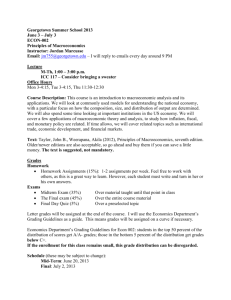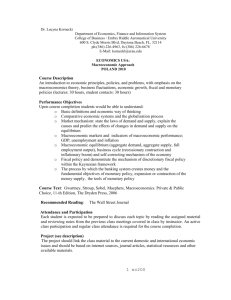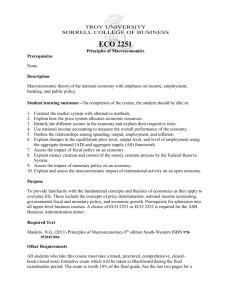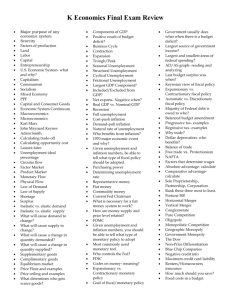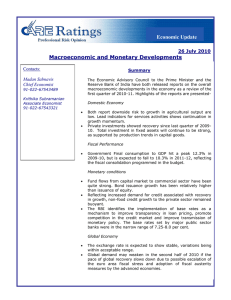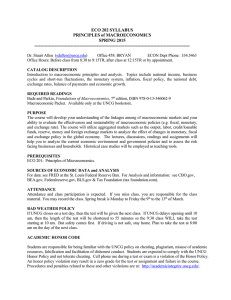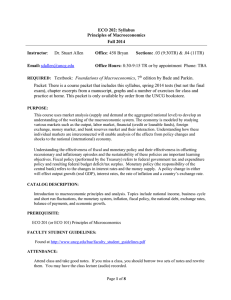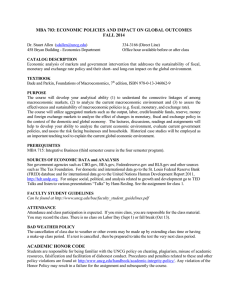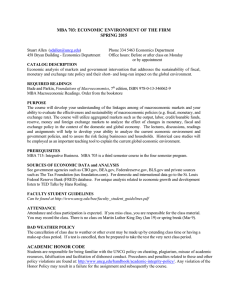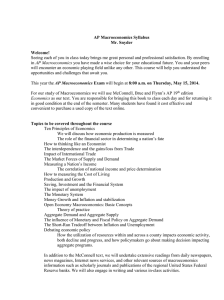MBA 703-51
advertisement
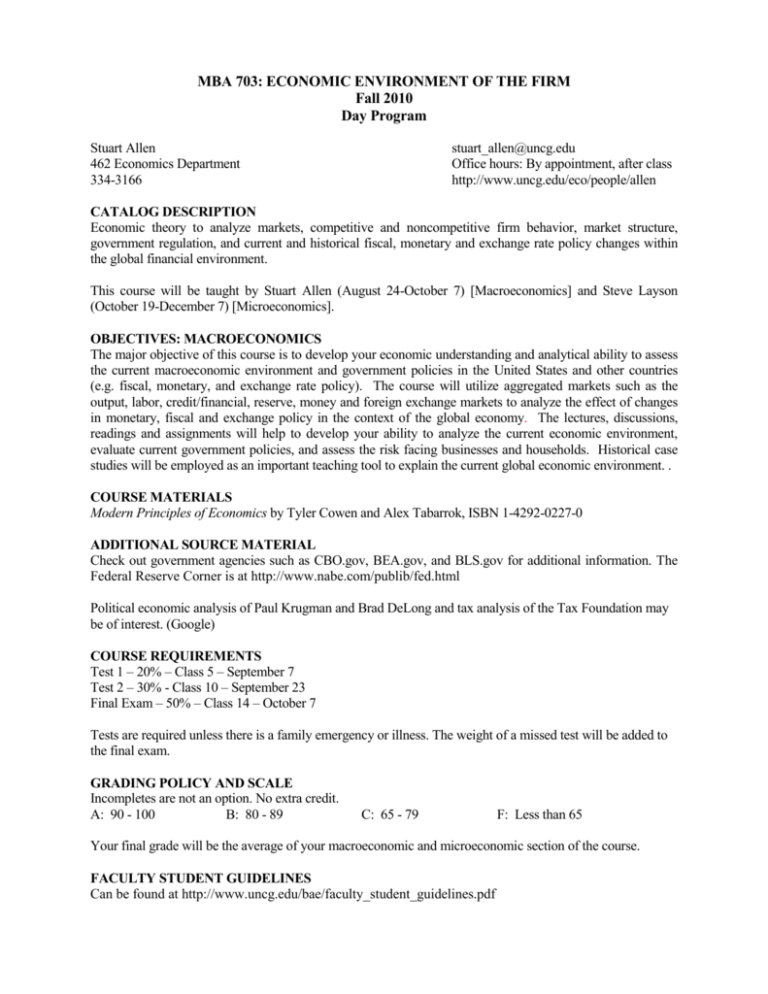
MBA 703: ECONOMIC ENVIRONMENT OF THE FIRM Fall 2010 Day Program Stuart Allen 462 Economics Department 334-3166 stuart_allen@uncg.edu Office hours: By appointment, after class http://www.uncg.edu/eco/people/allen CATALOG DESCRIPTION Economic theory to analyze markets, competitive and noncompetitive firm behavior, market structure, government regulation, and current and historical fiscal, monetary and exchange rate policy changes within the global financial environment. This course will be taught by Stuart Allen (August 24-October 7) [Macroeconomics] and Steve Layson (October 19-December 7) [Microeconomics]. OBJECTIVES: MACROECONOMICS The major objective of this course is to develop your economic understanding and analytical ability to assess the current macroeconomic environment and government policies in the United States and other countries (e.g. fiscal, monetary, and exchange rate policy). The course will utilize aggregated markets such as the output, labor, credit/financial, reserve, money and foreign exchange markets to analyze the effect of changes in monetary, fiscal and exchange policy in the context of the global economy. The lectures, discussions, readings and assignments will help to develop your ability to analyze the current economic environment, evaluate current government policies, and assess the risk facing businesses and households. Historical case studies will be employed as an important teaching tool to explain the current global economic environment. . COURSE MATERIALS Modern Principles of Economics by Tyler Cowen and Alex Tabarrok, ISBN 1-4292-0227-0 ADDITIONAL SOURCE MATERIAL Check out government agencies such as CBO.gov, BEA.gov, and BLS.gov for additional information. The Federal Reserve Corner is at http://www.nabe.com/publib/fed.html Political economic analysis of Paul Krugman and Brad DeLong and tax analysis of the Tax Foundation may be of interest. (Google) COURSE REQUIREMENTS Test 1 – 20% – Class 5 – September 7 Test 2 – 30% - Class 10 – September 23 Final Exam – 50% – Class 14 – October 7 Tests are required unless there is a family emergency or illness. The weight of a missed test will be added to the final exam. GRADING POLICY AND SCALE Incompletes are not an option. No extra credit. A: 90 - 100 B: 80 - 89 C: 65 - 79 F: Less than 65 Your final grade will be the average of your macroeconomic and microeconomic section of the course. FACULTY STUDENT GUIDELINES Can be found at http://www.uncg.edu/bae/faculty_student_guidelines.pdf 2 ATTENDANCE Attendance is necessary to absorb the course content. Missing class may be hazardous to your course performance. If the unexpected happens and you have to miss class, you are responsible for the class material. Class lectures may be recorded. UNCG HONOR POLICY IS ENFORCED 3 LEARNING OBJECTIVES Students should be able: 1. To understand the current economic news and to analyze current public policy. 2. To understand the measurement of macroeconomic data such as real GDP, economic growth, price indexes, inflation, unemployment, employment, the federal budget deficit, and the national debt. 3. To be able to convert (deflate) nominal variables to real variables. 4. To understand the measurement of a country’s balance of payments, the current and capital accounts and the status of a country as a debtor or creditor nation. 5. To discuss the sources of economic growth for developed and developing countries. 6. To analyze the effect of each of the three macroeconomic policies (fiscal, monetary, and exchange rate) with regard to real GDP growth, the unemployment rate, and the rate of inflation. 7. To understand the role of exchange rates in equilibrating trade and financial flows. 8. To analyze the effect of shifts in aggregate demand and aggregate supply in the output market in terms of short-run fluctuations in economic activity. 9. To analyze the effect of implementing expansionary and contractionary policy when the economy is suffering from recession or inflationary pressure. 10. To analyze the short- and long-term effects on real GDP growth and the inflation rate from the expansionary monetary policy of the late 1970s and Volcker’s fight against inflation from 1979-82. 11. To analyze the conduct of monetary policy (e.g. federal funds interest rate targeting) with specific reference to the interest rate targeting of the 1970s, the 1990s and the 2000s. 12. To analyze monetary policy according to Taylor’s rule. 13. To analyze the effects on economy activity and economic growth from fiscal policy and deficit spending with specific reference to the Reagan budget deficits. 14. To analyze the effect of the 1980s budget deficits and monetary policy on real interest rates, the current account deficit, the value of the dollar and the status of the US as a creditor or debtor nation. 15. To understand the Bretton Woods international financial system and the adjustment process. 16. To analyze the Asian currency crisis in 1997/98 and the role of fixed exchange rates in the boom and bust cycle. 17. To analyze the current exchange rate policy of China. 18. To analyze the reasons for the housing boom and bubble and the contributions by government. 4 MBA 703 COURSE OUTLINE You are requested to have read Chapters 1, 2, 3, 5, 20, 21, and 22 before the first day of class. I. GDP and Unemployment A. GDP: Nominal vs. Real B. GDP Per Capita C. Expenditure vs. Income Approval D. Trade and Balance of Payments E. Measurement Problems Ch. 20 Ch. 32, pp. 701-711 Insert: …… F. Unemployment Rate and Job Creation Ch. 24 G. Types: Cyclical, Fractural, and Structural H. National Rates of Unemployment and Full Employment: Potential Real GDP I. Okun’s Law and Growth Recession II. Economic Growth Chs. 21 and 22 A. Key Facts: Wealth Miracles and Wealth Disasters B. Rule of 70/? C. Wealth of Nations: Institution, Incentives, Physical Capital, Human Capital, Technology D. ? Growth Model E. Simple Model: Real GDP = F(K) F. Convergence Insert: PPF and Savings vs. Consumption ? Insert: Supply Scale Economics S→ K→ K/L Ratio→ Labor Productivity→ Real Wages→ ???? III. Savings, Investment and the Financial System A. Demand to Borrowers B. Supply by Lenders (?) C. Loanable Funds = Credit Market D. Role of Intermediaries E. Real vs. Nominal Interest Rates Ch. 23 5 IV. Money Supply, Inflation, and the ? Theory of ? Chs. 25 and 28 V. Dynamic AD-AS Model Chs. 25 and 27 VI. A. Monetary Policy B. Fiscal Policy VII. International Financial System Ch. 29 Chs. 30 and 31 Ch. 32
